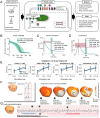This is a preprint.
T-World: A highly general computational model of a human ventricular myocyte
- PMID: 40196542
- PMCID: PMC11974879
- DOI: 10.1101/2025.03.24.645031
T-World: A highly general computational model of a human ventricular myocyte
Abstract
Cardiovascular disease is the leading cause of death, demanding new tools to improve mechanistic understanding and overcome limitations of stem cell and animal-based research. We introduce T-World, a highly general virtual model of human ventricular cardiomyocyte suitable for multiscale studies. T-World shows comprehensive agreement with human physiology, from electrical activation to contraction, and is the first to replicate all key cellular mechanisms driving life-threatening arrhythmias. Extensively validated on unseen data, it demonstrates strong predictivity across applications and scales. Using T-World we revealed a likely sex-specific arrhythmia risk in females related to restitution properties, identified arrhythmia drivers in type 2 diabetes, and describe unexpected pro-arrhythmic role of NaV1.8 in heart failure. T-World demonstrates strong performance in predicting drug-induced arrhythmia risk and opens new opportunities for predicting and explaining drug efficacy, demonstrated by unpicking effects of mexiletine in Long QT syndrome 2. T-World is available as open-source code and an online app.
Figures





References
-
- Passini E. et al. The virtual assay software for human in silico drug trials to augment drug cardiac testing. J Comput Sci 52, 101202 (2021).
Publication types
Grants and funding
LinkOut - more resources
Full Text Sources
